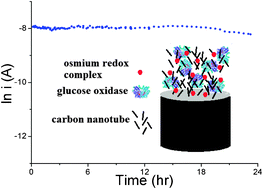Crosslinked redox polymer enzyme electrodes containing carbon nanotubes for high and stable glucoseoxidation current
Abstract
Co-immobilisation approaches for preparation of

* Corresponding authors
a
School of Chemistry & Ryan Institute, National University of Ireland Galway, Ireland
E-mail:
donal.leech@nuigalway.ie
Tel: +353-91 493563
b Instituto de Ciencia de Materiales de Madrid, Consejo Superior de Investigaciones Científicas, Madrid, Spain
Co-immobilisation approaches for preparation of

 Please wait while we load your content...
Something went wrong. Try again?
Please wait while we load your content...
Something went wrong. Try again?
D. MacAodha, M. L. Ferrer, P. Ó. Conghaile, P. Kavanagh and D. Leech, Phys. Chem. Chem. Phys., 2012, 14, 14667 DOI: 10.1039/C2CP42089A
To request permission to reproduce material from this article, please go to the Copyright Clearance Center request page.
If you are an author contributing to an RSC publication, you do not need to request permission provided correct acknowledgement is given.
If you are the author of this article, you do not need to request permission to reproduce figures and diagrams provided correct acknowledgement is given. If you want to reproduce the whole article in a third-party publication (excluding your thesis/dissertation for which permission is not required) please go to the Copyright Clearance Center request page.
Read more about how to correctly acknowledge RSC content.
 Fetching data from CrossRef.
Fetching data from CrossRef.
This may take some time to load.
Loading related content
